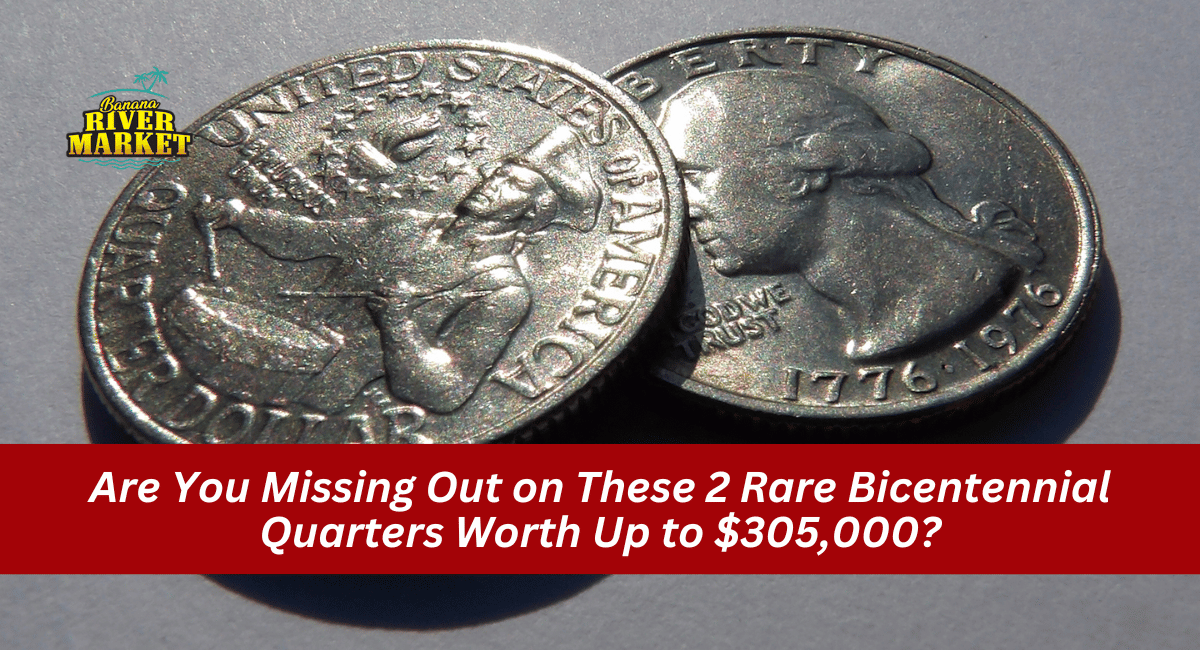When most people think of valuable coins, Bicentennial quarters rarely come to mind. However, there are two rare versions of these quarters from 1976 that could be worth a significant sum—up to $305,000!
If you have a collection of old quarters or just some loose change, it might be worth taking a closer look. Let’s dive into what makes these Bicentennial quarters so valuable and how to tell if you’re lucky enough to own one.
The Value of Bicentennial Quarters
Bicentennial quarters were issued in 1976 to celebrate America’s 200th birthday, and they feature unique designs with a colonial drummer on the reverse side. While most Bicentennial quarters are relatively common, there are two versions that stand out for their rarity and potential high value:
- The 1976-S Proof Bicentennial Quarter
- The 1976-D Bicentennial Quarter with Double Die Obverse
Let’s take a closer look at each of these valuable coins and what makes them so sought after.
1. The 1976-S Proof Bicentennial Quarter
What Makes It Valuable?
The 1976-S Proof Bicentennial Quarter is a special collectors’ edition that was not meant for regular circulation. These proof quarters were minted in San Francisco and have a unique “cameo” finish, meaning they have a mirror-like background with frosted design elements.
This distinct appearance, combined with its limited release, makes the 1976-S proof quarter highly desirable to collectors.
How Much Is It Worth?
For proof quarters graded at PR70 (the highest possible grade), recent auctions have seen these coins sell for over $200,000! This staggering price is due to their rarity, perfect condition, and high collector demand. Even if your 1976-S Proof Bicentennial Quarter isn’t in perfect condition, it could still be worth a considerable amount.
How to Identify It
Check for the “S” mintmark just below George Washington’s profile. Proof quarters are typically well-preserved, so if your coin has a glossy, mirror-like background with frosted details, it’s likely a proof quarter.
2. The 1976-D Bicentennial Quarter with Double Die Obverse
What Makes It Valuable?
The 1976-D Bicentennial Quarter with a double die obverse is another rare find. This error occurs when the coin’s design is accidentally struck twice, leading to a visible doubling effect on some design elements. You’ll likely notice the doubling on words like “Liberty” or the profile of George Washington.
How Much Is It Worth?
Depending on its condition and clarity of the doubling, these coins have been valued at up to $105,000! This makes the double die Bicentennial quarter one of the most valuable error coins from this series.
How to Identify It
Look closely at the coin’s obverse side (the side with George Washington’s profile). Doubling should be visible on certain inscriptions or design features. If you think you spot this error, consider getting it professionally appraised.
3. How to Check if You Have a Valuable Bicentennial Quarter
Finding a valuable Bicentennial quarter requires a careful eye. Here’s a quick checklist to help you examine your coins:
| Quarter Type | Key Features | Potential Value |
|---|---|---|
| 1976-S Proof Bicentennial | “S” mintmark, mirror-like finish | Up to $200,000 |
| 1976-D Double Die Obverse | Doubling on obverse details | Up to $105,000 |
Tips for Identifying Rare Quarters
- Use a magnifying glass to inspect details.
- Check the mintmark for “S” or “D” to identify the mint location.
- Examine for errors or unusual features, like doubling on the inscriptions.
4. Protecting and Appraising Your Valuable Coins
If you believe you have a rare Bicentennial quarter, preserving its condition is crucial. Here are some tips:
- Avoid excessive handling: Oils from your hands can affect a coin’s condition.
- Store in protective cases: Keep your coins in coin holders or plastic capsules to protect them from scratches or environmental damage.
- Get an appraisal: To determine the exact value, have your coin appraised by a reputable coin dealer or grading service. Certification by agencies like PCGS or NGC can help verify and maximize the coin’s value.
Conclusion
While most Bicentennial quarters are worth face value, these rare versions—the 1976-S Proof and the 1976-D Double Die Obverse—can fetch tens or even hundreds of thousands of dollars.
Take a closer look at your coin collection or pocket change, as you might be sitting on a hidden treasure. Remember to store any potentially valuable coins carefully and consider getting a professional appraisal to uncover their true worth.
FAQs
Proof coins usually have a glossy, mirror-like background with frosted design elements. The 1976-S Proof Bicentennial Quarter will also have an “S” mintmark below Washington’s profile, indicating it was minted in San Francisco.
A double die obverse is a minting error where the coin’s design is accidentally struck twice, resulting in noticeable doubling on certain details. Collectors value these coins for their rarity and unique appearance.
Most circulated Bicentennial quarters are common and not highly valuable. However, specific varieties like the 1976-S Proof and 1976-D double die quarters can be extremely valuable, especially if well-preserved.
To maintain their condition, store valuable coins in protective holders or capsules. Avoid handling them directly and keep them in a cool, dry place to prevent tarnishing.
Seek out a reputable coin dealer or grading service like PCGS (Professional Coin Grading Service) or NGC (Numismatic Guaranty Corporation) for an accurate appraisal. A certified grade can significantly impact your coin’s value.
READ MORE: 5 Most Valuable Coins Discovered in Unexpected Places

